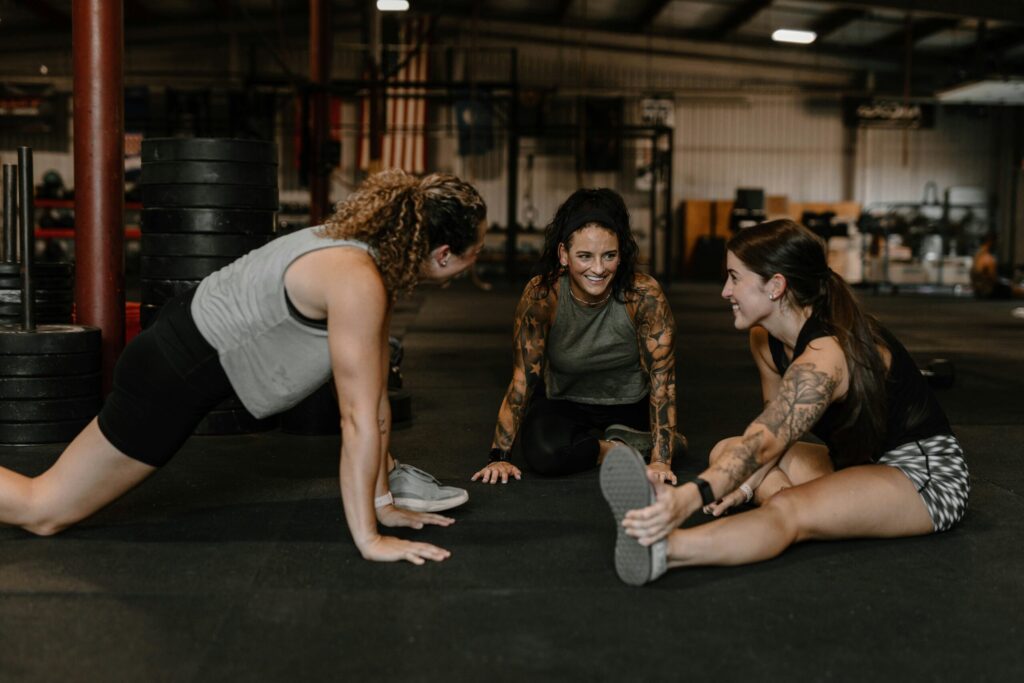The rise of fitness communities.
Fitness communities have become a growing trend, bringing together individuals, online or in person, who share an interest in movement, strength, and health. Instead of following highly individualized routines, people are seeking a shared experience. They want accountability, a connection, and most importantly, to feel like they belong to something bigger than themselves (Clejan et al., 2022).
This new wave is about a significant shift from solo workouts and programs to something more sustainable and progressive: community workouts and programs.
What Is a Fitness Community and How Are They Formed?
A fitness community is a group of people with common goals joining together to complete a fitness routine. It could be a group of moms supporting each other in regaining their strength postpartum, or a group of midlife women encouraging each other in their fitness journey. These groups often form around a common interest or goal, like training for a marathon, navigating postpartum recovery, or gaining strength during perimenopause.
Communities can be created in various ways: through a gym or studio, an online platform, or a private group on social media. Regardless of where they’re hosted, most fitness communities have three key things in common:
- A shared goal (like building postpartum strength, running a race, or staying strong through midlife);
- A shared identity (moms, midlife women, beginner lifters); and
- Shared values such as inclusivity, body neutrality, showing up imperfectly, and progress over perfection are the foundation of many fitness communities. These values create an inclusive and supportive environment where everyone’s journey is respected and celebrated.
These are not just workout groups but intentional spaces where people connect through more than reps and routines (Golaszewski et al., 2022).
Why Fitness Communities Work
Being part of a fitness community allows individuals to build meaningful connections. It helps to reduce the loneliness that often comes with starting, restarting, or trying to maintain a fitness routine, especially when balancing other life demands.
It also helps with consistency. When you know someone is expecting you to show up or someone is rooting for you, it becomes easier to follow through, even on the hard days. That kind of support and accountability creates a space where people can ask questions, get feedback, vent, and celebrate wins.
There is also a significant mental shift when you are part of a community. The intimidation that often comes with starting something new begins to fade when you see others navigating it with you (Whiteman-Sandland et al., 2018). You feel less alone and more encouraged. Motivation is boosted by friendly challenges, seeing others stay committed, or knowing you’re not the only one making the effort.
Fitness communities also play a crucial role in supporting personal growth. They create space for mindset shifts, confidence building, and long-term mental resilience, not just physical gains. This empowerment is a key aspect of their appeal (Golaszewski et al., 2022; Whiteman-Sandland et al., 2018).
The Bigger Picture
While this may seem like another fitness trend, it reflects something bigger. Culturally, we are moving away from perfection and toward belonging. Fitness communities highlight progress over aesthetics. People in these groups focus on feeling stronger and more capable in their everyday lives (Clejan et al., 2022).
You can see this shift in the way programs are being delivered:
- Fitness apps now include messaging features to foster connection
- Studios are introducing group boards and shared events.
- Coaches build programs around shared values and identity, not just sets and reps.
The future of fitness isn’t just about working harder. It’s about being part of something that supports you while you grow mentally, emotionally, and physically.
Where to Find (or Start) a Fitness Community
If you want to join a fitness community, you don’t have to look far. There are more options now than ever:
- Gyms and studios often host group classes or small training groups that foster connection beyond the workout. Some even have member boards or challenges to bring people together.
- Online platforms like fitness apps or coaching programs often include community features like group chats, message boards, or coaching circles, so you’re not training in isolation.
- Social media can be a great place to connect with like-minded individuals. Facebook groups, local meetups, and Instagram communities built around shared goals or identities can offer support and encouragement.
And if you don’t see the kind of community you are looking for? You can start your own. If that’s your choice, start small. Gather a few friends or clients who are working toward similar goals. Choose a space to connect—maybe a group text thread, a private Facebook group, or a recurring Zoom meetup. Set a common focus, whether walking three times a week, strength training, or just sharing how workouts are going. The key is consistency, mutual support, and space for honest conversations, not perfection. Fitness does not have to be lonely, rigid, or performance-based. A strong community can change how we feel about movement, motivation, and ourselves, and that is a trend worth following.
References
1. Clejan I, Congleton CD, Lerch BA. The emergence of group fitness. Evolution. 2022 Aug;76(8):1689-1705. doi: 10.1111/evo.14549. Epub 2022 Jul 15. PMID: 35767747.
2. Whiteman-Sandland J, Hawkins J, Clayton D. The role of social capital and community belongingness for exercise adherence: An exploratory study of the CrossFit gym model. J Health Psychol. 2018 Oct;23(12):1545-1556. doi: 10.1177/1359105316664132. Epub 2016 Aug 23. PMID: 27553606.
3. Golaszewski NM, LaCroix AZ, Hooker SP, Bartholomew JB. Group exercise membership is associated with forms of social support, exercise identity, and amount of physical activity. Int J Sport Exerc Psychol. 2022;20(2):630-643. doi: 10.1080/1612197x.2021.1891121. Epub 2021 Mar 1. PMID: 35494549; PMCID: PMC9053316.
